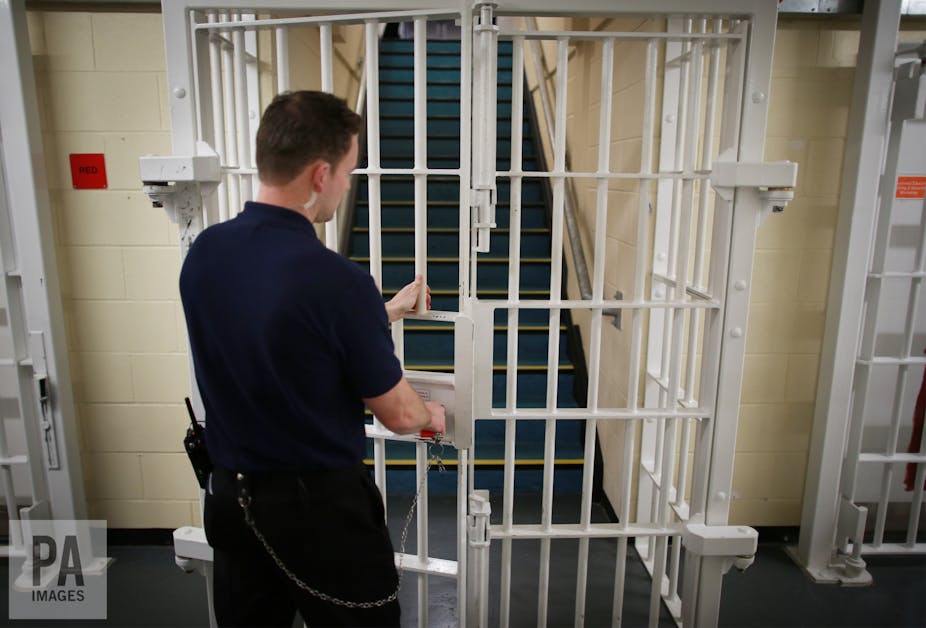Prison officers are to receive a 1.7% pay rise in a move which effectively breaks the 1% public sector pay cap, but is far less than the 5% the Prison Officer’s Association had been asking for.
The move comes as the government is trying to recruit 2,500 new prison officers in an effort to combat the current crisis of violence and disorder in prisons. The government argues that the extra officers will allow the newly created HM Prison and Probation Service (HMPP) – formally the National Offender Management Service – to run 109 of the 123 prisons in England and Wales safely and securely. The others are run by private providers.
On paper, being a prison officer presents the possibility of having an interesting and varied career. Officers work in both prisons and secure psychiatric hospitals, earning from £20,000 up to £38,000 a year for a 37- to 39-hour-week. No particular qualifications are required. There is on-the-job training (an initial ten weeks) and the possibility of developing specialist skills in different aspects of rehabilitation.
The latest figures from the Ministry of Justice (MoJ) show that at the end of June 2017 there were the highest number of prison officers in post since 2013 – due to the recruitment of 665 new officers over the previous year.
This has been helped by the introduction of a new graduate scheme enabling people with university degrees to work in frontline prison roles. The scheme, called Unlocked Grads, says it encourages the “brightest and the best” to become leaders in criminal justice settings. This is a new initiative and only time will tell if it has a positive impact.
The state of prisons
The trade union, the Prison Officer’s Association, says that the prison service is in meltdown. It argues that prisons have become a place of violence – for both prisoners and prison officers.
The Prison Reform Trust (PRT) has reported that 27% of frontline prison officers quit after completing two years in the role. A decline of support staff means that officers have to cover other tasks, diverting them from direct prisoner work. MoJ figures show that support staff are now at the lowest level since 2010.
On September 15, 2017 the numbers of prisoners was 86,252, which is 99% of “operational capacity” (the number that can be physically housed) in a system whose “uncrowded capacity” (representing a good and decent standard of accommodation) is considerably lower.
The PRT data shows that nearly a quarter of the prison population are sharing cells that have been designed for one person. Nearly 6,500 fewer staff are looking after 300 more prisoners, many of whom have complex combinations of substance misuse, mental health, physical health and social needs.
In 2009, the Bradley Report into learning difficulties and mental health problems in the criminal justice system reported that the majority of prisoners have these complex needs. In my own work, my colleagues and I have showed that since the publication of this report very little has changed in meeting those needs.
However, a focus solely on prisons and staff recruitment continues to overlook a number of problems. To understand the prisons “crisis”, we must look beyond what is happening in prisons and to the wider criminal justice system.
Community sentences failing
It is encouraging that the current justice secretary, David Lidington, wants to see a decrease in prison numbers. He also argues for the courts to have more confidence in the use of community sentences. However, prisons reflect the wider dynamics of the community. Currently, they reflect a whole systems failure due to the political choice of austerity and badly thought through “reorganisation”. This has disproportionately affected some of the most vulnerable people in society.
In this respect, the government’s reorganisation of the National Probation Service (NPS) in 2014 has been highly criticised. The service has been split into two: the NPS supervises “high-risk offenders”, with Community Rehabilitation Companies (CRC) supervising “low-risk offenders”. A justification for the change was to ensure that prisoners serving short sentences would be supervised for a minimum of 12 months upon release. The CRCs, made up of charities and peer mentoring schemes run by ex-offenders, were meant to bring valuable expertise to breaking the cycle of crime.
Unfortunately, the PRT has demonstrated that the recall population (the number of people being sent back to prison) has increased by nearly a thousand since the changes were introduced. Recent inspectorate reports have been scathing about the performance of CRCs and the impact of schemes to help resettlement.
Prisons, while affected by austerity, still have the most resources in comparison to community and probation services and so when deciding how best to deal with offenders who have complex needs, prison too readily becomes the first option rather than the last.
These decisions are entirely due to sentencing practice rather than more crimes being committed. Criminal justice finds itself in the eye of a perfect storm in which the use of community sentences has halved since 2006 despite being more effective in reducing re-offending. When these sentences are used, too many people are recalled to prison often due to cuts in housing and support services.
Recruitment of good quality staff is of course essential, but it is worth remembering that there was still a prison crisis when prisons were fully staffed – precisely because these problems reflect the wider dynamics of the criminal justice system.

